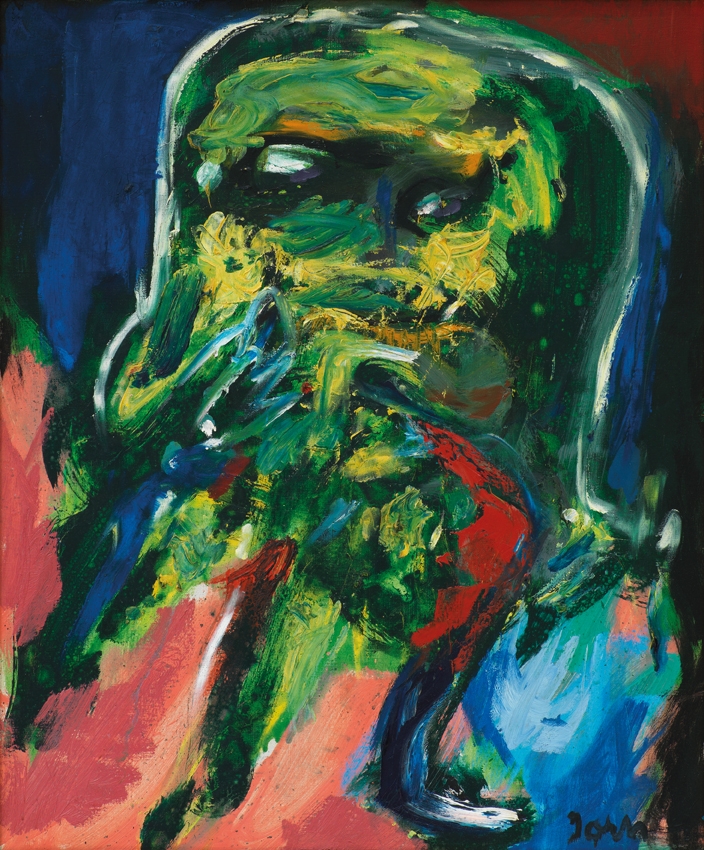Asger Jorn: The Open Hide, 5 May – 29 July 2016, Petzel, New York
Is it safe to say that Asger Jorn is rising from the dead, at least in New York? The artist passed in 1973, and the last show of his work was mounted here exactly two decades later. Jorn and CoBrA, the bright, brief movement with which, after the Situationist International, he is most closely associated, was just becoming fodder for PhD students during the 1990s (two of my colleagues in New York were ‘working on’ Jorn at the time). This likely had something to do with T.J. Clark, the eminent historian of artistic Modernism, naming Jorn ‘the greatest painter of the 1950s’, which he did at a conference in 1992. But things went quiet for another two decades, and then the journal October, in 2012, dedicated a special issue to the artist and his writings; in 2014 Karen Kurczynski published The Art and Politics of Asger Jorn: The Avant-Garde Won’t Give Up (Routledge); and the following year Blum & Poe mounted The Avant-Garde Won’t Give Up, a two-part exhibition in New York and Los Angeles dedicated to all things CoBrA (both Kurczynski’s book and the Blum & Poe show are titled after a signal work by Jorn). Who says the market doesn’t follow history?
Now, this year, Petzel gives us The Open Hide (also the title of a Jorn work), an episodic retrospective of Jorn’s paintings from the early 1940s to the first years of the 70s. There isn’t enough work on offer from the 1950s to adjudicate Clark’s claim, but let’s just say this: Jorn could paint.
What The Open Hide offers, among many things, is a brief glimpse of a transition that takes place in Jorn’s work, from an early fascination with ‘the animal’ as a symbolic and so representational category, to the ‘face’ as the same. This isn’t to suggest a consistent, linear move, but it is certainly the case that, in its time, CoBrA seized on animal figures and symbols as a means to challenge the status of ‘man’ in the wake of the European conflagration that was the Second World War. Yet Jorn’s interest in our animal nature (as challenge to our human ‘culture’) predates his involvement in CoBrA. The double-sided work Animaux animé(s) (1944/46), an almost cartoonish jungle scene, marries Matisse of the Bonheur de vivre (1905–6) to lessons learned from Fernand Léger, with whom Jorn studied in France. By the end of the 1940s, however, the model of Matisse’s idyll had been replaced by the dark, dense and confrontational Untitled (Phoenix) (1949/50). This is a CoBrA work, in which two sets of eyes glare at us from within a black shroud, and little effort is made to sublimate the viscosity of paint.
Later in the 1950s, Jorn produces Portrait: Signora Albissola (1957), which channels Pollock, but also Wols, an immensely important painter and precedent for Jorn – witness the aggressive abstract materiality of works such as Oriental Fire/Sanoyara (1958). By the 1960s though it’s faces: Untitled (Faces in a Head) (c. 1960) recalls the confrontation of the Phoenix picture but now with a distinctly Frankensteinian visage rendered in greens, blues, browns and reds. Green takes over in Actor in Action (1967), where Jorn’s juxtaposition of a type of smearing stroke with rough scratches and thicker daubs of paint creates alternating pockets of blur and focus. This is the human animal that mere symbolism could never quite touch.
The latest works in the show suggest that Jorn thought all that heavy paint was too symbolic as well. The Open Hiding Place (1970), a lithograph, and an untitled gouache on paper from 1971, give up on figures of any sort. In their place are rapid marks in light, bright colours – not desperate, but urgent: marks meant to hold on to life.
This article was first published in the Summer 2016 issue of ArtReview.
